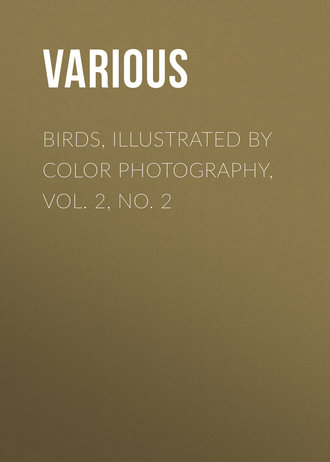 полная версия
полная версияBirds, Illustrated by Color Photography, Vol. 2, No. 2
Eggs – Six to twelve; creamy buff.
Page 60.
YELLOW LEGS.—Totanus flavipes.
Range – North America, breeding chiefly in the interior from Minnesota, northern Illinois, Ontario County, N. Y., northward to the Arctic regions; winters from the Gulf States to Patagonia.
Eggs – Three or four; buffy, spotted or blotched with dark madder – or van dyke – brown and purplish gray.
Page 61.
SKYLARK.—Alauda arvensis.
Range – Europe and portions of Asia and Africa; accidental in the Bermudas and in Greenland.
Nest – Placed on the ground, in meadows or open grassy places, sheltered by a tuft of grass; the materials are grasses, plant stems, and a few chance leaves.
Eggs – Three to five, of varying form, color, and size.
Page 66.
WILSON’S PHALAROPE.—Phalaropus tricolor.
Range – Temperate North America, breeding from northern Illinois and Utah northward to the Saskatchewan region; south in winter to Brazil and Patagonia.
Nest – A shallow depression in soft earth, lined with a thin layer of fragments of grass.
Eggs – Three to four; cream buff or buffy white, heavily blotched with deep chocolate.
Page 70.
EVENING GROSBEAK.—Cocothraustes vespertina.
Range – Interior of North America, from Manitoba northward; southeastward in winter to the upper Mississippi Valley and casually to the northern Atlantic States.
Nest – Of small twigs, lined with bark, hair, or rootlets, placed within twenty feet of the ground.
Eggs – Three or four; greenish, blotched with pale brown.
Page 73.
TURKEY VULTURE.—Catharista Atrata.
Range – Temperate America, from New Jersey southward to Patagonia.
Nest – In hollow stump or log, or on ground beneath bushes or palmettos.
Eggs – One to three; dull white, spotted and blotched with chocolate marking.
Page 78.
GAMBEL’S PARTRIDGE.—Callipepla gambeli.
Range – Northwestern Mexico, Arizona, New Mexico, southern Utah, and western Utah and western Texas.
Nest – Placed on the ground, sometimes without any lining.
Eggs – From eight to sixteen.











